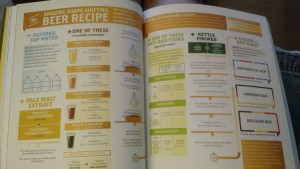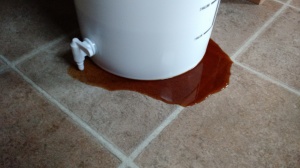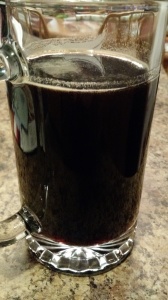Tag Archive: Charlie Papazian
Five Books Homebrewers Should Read
Thanks to Old Man Winter and Mother Nature (both of whom SUCK), I hurt my back shoveling snow and was resting a lot over the weekend and week. Since I couldn’t work on the electric kettle (and I had the incorrect solid-state relays), everything was held off for a week.
So I started reading another beer book and thought that I’d post something about them. This list is NOT EXCLUSIVE! There is a lot of great brewing literature out there – I’m just going to talk about the four I’ve liked the most so far. These are in no order, either.
1. How To Brew by John Palmer
I’ve read this probably three times, twice on his website and a third reading the Third Edition on Kindle. The thing I like about this book is that it is very step-by-step and practical, and when he goes into discussion about what is happening behind the scenes (particularly in the all-grain chapters), the author clearly indicates that he is going to explain things for a while and what chapter to go to if you just want to brew. In fact, the author does that in another place – the beginning. The book starts out with brewing your first extract brew (which I believe is a good place to start, even if you brew one extract brew like me).
2. The Complete Joy of Homebrewing by Charlie Papazian
After reading How To Brew, this is a little bit of a review, but I think this book clearly shows that brewing beer is not an uptight process. The book drives home the point of “Relax, don’t worry, have a homebrew”. It is somewhat of a review after reading How To Brew, but still a good read nonetheless. The book also talks about the historical context of beer and brewing.
3. The Brewer’s Apprentice by Greg Koch and Matt Allyn
First off, brewing books written by some of the most respected craft brewers should ALWAYS be read. Greg Koch is the CEO of Stone Brewing, brewers of such high-quality brews as Arrogant Bastard Ale, several excellent IPAs (Levitation*, Self-Righteous, Ruination 1.0 [and probably 2.0, too], and many others), as well as one of my favorite milk stouts. And while I’ve skipped out on the recent Green Tea and Golden Stout collaborations, the Xocoveza Mocha Stout collaboration was excellent. Anyway, the book is more of a thinking book than a howto book (unlike the two above). There is a lot of discussion about specific ingredients (like hops) and specific processes (like mashing). This is a book to read with a beer in your hand when your carboys are full and you want to think about brewing the next beer.
4. Tasting Beer: An Insider’s Guide to the World’s Greatest Drink by Randy Mosher
This book is not about brewing, it’s about tasting. Tasting is an important part of brewing beer, especially if you want to brew better beers (and who doesn’t?). Taste is a critical part of evaluating beer, whether it’s your own or someone else’s. It’s also an important part of recipe formulation. This book really hits its stride around chapter 4 when the discussion moves into the sensory evaluation of beer (judging), beer presentation (glassware, pouring, etc), and beer and food pairing.
5. Mastering Homebrew by Randy Mosher
This is a book that should be purchased as a printed book as opposed to an eBook version. While it is a little more expensive that way, the book is full of pictures and tables that explain a lot of the more complex brewing processes in a simpler, almost infographic-with-text-explanation style.
I think I like reading this one at this point (6 or 7 brews, 4 or 5 all-grain brews) because of the intense discussion of grains and hops (so far), and I’m probably about 40% of the way through the book.
Cheers!
Charlie Is Right. RDWHAHB.
The words of Charlie Papazian in his book, The Complete Joy of Homebrewing (if you don’t own it, click that link and buy it, help support my site!) ring out on nearly every beer forum anywhere. It’s hard to follow the advice sometimes, but that doesn’t change that the advice is good.
My last brew is one that was… interesting. It was my first all-grain brew, and it was big. I also messed up a few places, I forgot to add the lactose until into the boil. I didn’t get the yield I wanted (and didn’t sparge to get it, even though I should have). My OG was high.
Fermentation was interesting, too. I split the batches, which resulted in about 2.25 gal (8.5 l) of wort once boil was over. I used Wyeast 1968, with a starter, which may have gone according to plan. I fermented one in a carboy and one in a bucket. The carboy bubbled and bubbled. In fact, I let it ferment an extra week because of how bubbly it was! Even with the FG settled at 1.034 (readings taken over a week apart, not just 3 days), it was still bubbling like it was fermenting. The bucket didn’t start bubbling at all. At one point I thought maybe it needed to be aerated and I shook (sort of) the bucket. It bubbled then (and only then) and so much so it pushed all the sanitizer out of the airlock. It’s FG settled to nearly the same as the carboy.
I will admit, I was worrying. The samples were a little thick and too sweet. I don’t care much for sweet beers. Two nights before bottling, I added a shot of vanilla tincture to one. The night before bottling, I added around 8oz of cold coffee to the other. I bottled them on the day before Thanksgiving, not without a minor issue.
I try- but never succeed- in giving beers a full two weeks of bottle conditioning. I put one of each batch in the fridge 10 days after bottling, and cracked one open as a nightcap after one of my kids’ birthday party. It was the vanilla, affectionately known as E=1/2mvStout (yes, I’m an engineer). I was still concerned that it would be thick, sweet, and not good.
I was wrong!
It was good. The vanilla was not as strong as I wanted (but perhaps I could have that as a play on the ‘1/2’ in the kinetic energy formula). The head is not what I wanted, but it’s a starting point, and a damn good one.
So the next evening I tried the coffee one, E=MCStout. I was concerned all along that the coffee flavor could overpower this one, as I have had coffee stout beers that were just too powerful with the coffee. At this point, though, I knew it was at least a 3.5 star beer, so I was less apprehensive about trying it.
It was better. Better than the vanilla stout.
The moral of the story: Mr. Papazian is right. Relax, don’t worry. Have a homebrew.
Prost!


